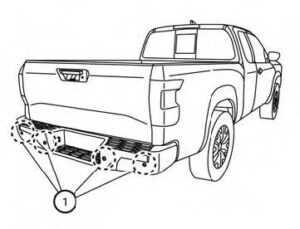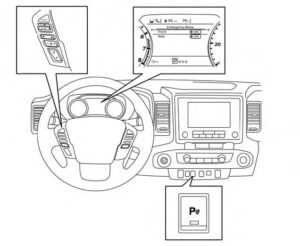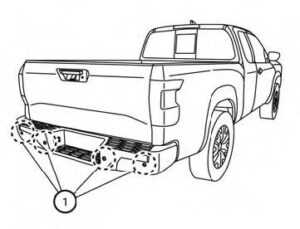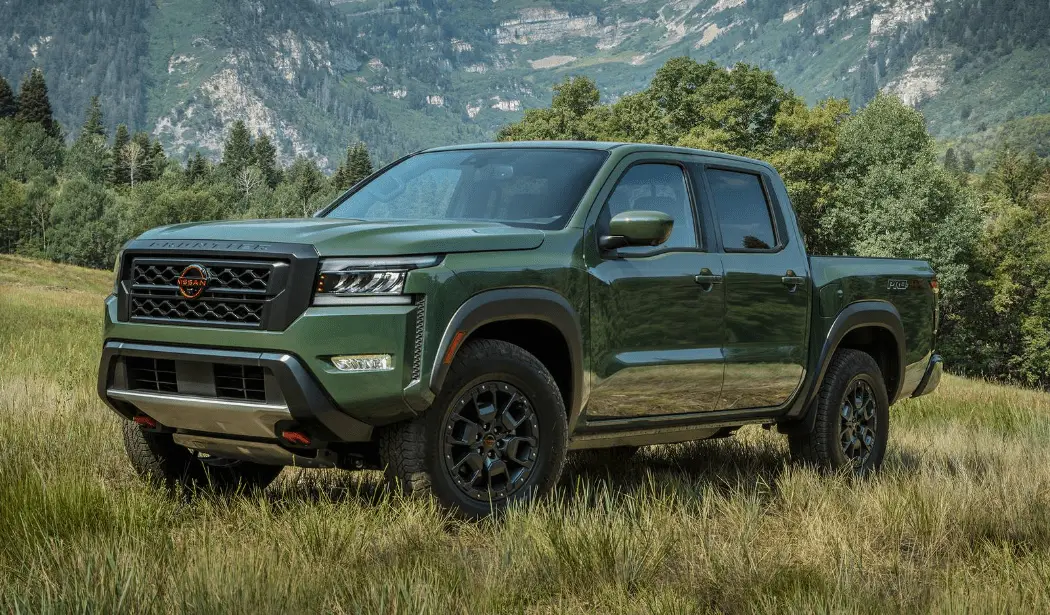Nissan FRONTIER 2023 Rear Automatic Braking
A full range of cutting-edge safety and convenience technologies, such as intelligent cruise control and rear cross-traffic alert (RCTA), are available on the 2023 Nissan Frontier. By sending out notifications when it detects other vehicles or impediments when the car is in reverse, RCTA improves safety during parking and backing out of confined places. In contrast, the Frontier’s Cruise Control system provides adaptive features that make driving on the highway more comfortable and less taxing on the driver by enabling the vehicle to maintain a certain speed and even modify it in response to traffic conditions. These features demonstrate Nissan’s commitment to providing a comprehensive driving experience by fusing convenience and security to make every trip in the Frontier safe and pleasurable.
2023 Nissan Frontier Specs, Price, Features and Mileage (Brochure)
Rear Automatic Braking (RAB)
WARNING
Failure to follow the warnings and instructions for proper use of the RAB system could result in serious injury or death.
- The RAB system is a supplemental aid to the driver. It is not a replacement for proper driving procedures. Always use the side and rear mirrors and turn and look in the direction you will move before and while backing up. Never rely solely on the RAB system. It is the driver’s responsibility to stay alert, drive safely, and be in control of the vehicle at all times.
- There is a limitation to the RAB system capability. The RAB system is not effective in all situations.
- Inclement weather or ultrasonic sources such as an automatic car wash, a truck’s compressed air brakes, or a pneumatic drill may affect the function of the system; this may include reduced performance or a false activation.
The RAB system can assist the driver when the vehicle is backing up and approaching objects directly behind the vehicle.
The RAB system detects obstacles behind the vehicle using the parking sensors 1O located on the rear bumper.
NOTE:
You can temporarily cancel the sonar function in the vehicle, but the RAB system will continue to operate. 
RAB SYSTEM OPERATION
- RAB system warning light and RAB system indicator
- Steering-wheel-mounted controls (left
- Center display
When the shift lever is in the R (Reverse) position and the vehicle speed is less than approximately 9 mph (15 km/h), the RAB system operates. If a risk of a collision with an obstacle is detected when your vehicle is backing up, the RAB system warning indicator will flash in the vehicle information display, a red frame will appear in the center display (for vehicles with the Intelligent Around View® Monitor system), and the system will chime three times. The system will then automatically apply the brakes. After the automatic brake application, the driver must depress the brake pedal to maintain brake pressure.
NOTE:
- The brake lights of the vehicle come on when braking is performed by the RAB system.
- When the brakes operate, a noise may be heard. This is not a malfunction.

TURNING THE RAB SYSTEM ON/OFF
Perform the following steps to turn the RAB system on or off.
- Press the button until “Settings” displays in the vehicle information display and then press the ENTER button. Use the button to select “Driver Assistance.” Then press the ENTER button.
- Select “Emergency Brake” and press the ENTER button.
- Select “Rear” and press the ENTER button to turn the system on or off.
- Push the Parking Aids system switch to turn the system on or off.
When the RAB system is turned off, the RAB warning light illuminates.
NOTE:
The RAB system will be automatically turned on when the engine is restarted.
RAB SYSTEM LIMITATIONS
Listed below are the system limitations for the RAB system. Failure to follow the warnings and instructions for proper use of the RAB system could result in serious injury or death.
- When the vehicle approaches an obstacle while the accelerator or brake pedal is depressed, the function may not operate or the start of operation may be delayed. The RAB system may not operate or may not perform sufficiently due to vehicle conditions, driving conditions, the traffic environment, the weather, road surface conditions, etc. Do not wait for the system to operate. Operate the brake pedal by yourself as soon as necessary.
- If it is necessary to override RAB operation, strongly press the accelerator pedal.
- Always check your surroundings and turn to check what is behind you before and while backing up. The RAB system detects stationary objects behind the vehicle.
- The RAB system does not detect the following objects:
- Moving objects
- Low objects
- Narrow objects
- Wedge-shaped objects
- Objects close to the bumper (less than approximately 1 ft [30 cm])
- Objects that suddenly appear
- Thin objects such as rope, wire, chain, etc.
- The RAB system may not operate because of the following obstacles:
- Obstacles located high off the ground
- Obstacles in a position offset from your vehicle
- Obstacles, such as spongy materials or snow, that have soft outer surfaces and can easily absorb a sound wave
- The RAB system may not operate in the following conditions:
- There is rain, snow, ice, dirt, etc., attached to the sonar sensors.
- A loud sound is heard in the area around the vehicle.
- The surface of the obstacle is diagonal to the rear of the vehicle.
- The RAB system may unintentionally operate in the following conditions:
- There is overgrown grass in the area around the vehicle.
- There is a structure (e.g., a wall, toll gate equipment, a narrow tunnel, a parking lot gate) near the side of the vehicle.
- There are bumps, protrusions, or manhole covers on the road surface.
- The vehicle drives through a draped flag or a curtain.
- There is an accumulation of snow or ice behind the vehicle.
- An ultrasonic wave source, such as another vehicle’s sonar, is near the vehicle.
- Once the automatic brake control operates, it does not operate again if the vehicle approaches the same obstacle.
- The automatic brake control can only operate for a short period of time. Therefore, the driver must depress the brake pedal.
- In the following situations, the RAB system may not operate properly or may not function sufficiently:
- The vehicle is driven in bad weather (rain, fog, snow, etc.).
- The vehicle is driven on a steep hill.
- The vehicle’s posture is changed (e.g., when driving over a bump).
- The vehicle is driven on a slippery road.
- The vehicle is turned sharply by turning the steering wheel fully.
- Snow chains are used.
- Wheels or tires other than NISSAN recommended are used.
- The brakes are cold at low ambient temperatures or immediately after driving has started.
- The braking force becomes poor due to wet brakes after driving through a puddle or washing the vehicle.
- Turn the RAB system off in the following conditions to prevent the occurrence of an unexpected accident resulting from sudden system operation:
- The vehicle is towed.
- The vehicle is carried on a flatbed truck.
- The vehicle is on the chassis dynamometer.
- The vehicle drives on an uneven road surface.
- The vehicle is towing an object (if so equipped).
- Suspension parts other than those designated as Genuine NISSAN parts are used. (If the vehicle height or the vehicle body inclination is changed, the system may not detect an obstacle correctly.)
- If the vehicle is using an accessory like a bike rack, or cargo carrier that blocks the sensors.
- Excessive noise (e.g., audio system volume, an open vehicle window) will interfere with the chime sound, and it may not be heard.
SYSTEM MALFUNCTION
If the RAB system malfunctions, it will be turned off automatically, and the RAB system warning light will illuminate and the warning message “System fault See Owner’s Manual” in the vehicle information display.
Action to take
If the warning light illuminates, park the vehicle in a safe location, turn the engine off, and restart the engine. If the warning light continues to illuminate, have the RAB system checked. It is recommended that you visit a NISSAN dealer for this service.
NOTE:
If the RAB system cannot be operated temporarily, the RAB system warning light blinks.
SYSTEM MAINTENANCE
Observe the following items to ensure the proper operation of the system:
- Always keep the parking sensors 1O clean.
- If the parking sensors are dirty, wipe them off with a soft cloth while being careful to not damage them.
- Do not subject the area around the parking sensors 1O to strong impact. Also, do not remove or disassemble the parking sensors. If the parking sensors and peripheral areas are deformed in an accident, etc., have the sensors checked. It is recommended that you visit a NISSAN dealer for this service.
- Do not install any stickers (including transparent stickers) or accessories on the parking sensors 1O and their surrounding areas. This may cause a malfunction or improper operation.
FAQ
Rear Automatic Braking (RAB) is a safety feature in the Nissan FRONTIER 2023 that helps prevent or mitigate collisions when the vehicle is in reverse by automatically applying the brakes if an obstacle is detected behind the vehicle.
When the vehicle is in reverse, Rear Automatic Braking (RAB) uses sensors and cameras to monitor the area behind the vehicle. If an obstacle, such as a vehicle or pedestrian, is detected, the system will activate and apply the brakes to help avoid or minimize a collision.
Yes, Rear Automatic Braking (RAB) can typically be disabled or adjusted through the vehicle’s settings or infotainment system. Refer to the owner’s manual for instructions on how to enable or disable the feature.
Rear Automatic Braking (RAB) is primarily designed for low-speed reversing situations. Its effectiveness may vary depending on the speed and distance of the detected obstacle.
Rear Automatic Braking (RAB) is designed to detect a variety of obstacles, including vehicles, pedestrians, and stationary objects, that may be behind the vehicle while in reverse.
Rear Automatic Braking (RAB) is typically programmed to detect larger objects or obstacles that may pose a significant risk of collision. It may not be triggered by small objects or low obstacles close to the ground.
No, Rear Automatic Braking (RAB) is an additional safety feature but should not replace the driver’s responsibility to drive safely, use mirrors, and check the surroundings when reversing.
While Rear Automatic Braking (RAB) can help mitigate or prevent collisions in certain situations, it may not be able to prevent all collisions. The driver should remain vigilant and exercise caution when reversing.
Yes, Rear Automatic Braking (RAB) is specifically designed to operate when the vehicle is in reverse gear. It is not active during forward driving.
Rear Automatic Braking (RAB) is primarily designed to detect stationary objects behind the vehicle. While it may detect moving objects, its effectiveness may be limited in such situations.
Adverse weather conditions, such as heavy rain, snow, or fog, may affect the performance of Rear Automatic Braking (RAB). It is always recommended to exercise caution and drive carefully in such conditions.
Rear Automatic Braking (RAB) is typically an optional feature that can be enabled or disabled by the driver. It is recommended to refer to the owner’s manual for instructions on how to activate or deactivate the feature.
Yes, when Rear Automatic Braking (RAB) detects an obstacle, it may provide audible alerts, such as beeping sounds, and visual warnings on the vehicle’s display or instrument panel to alert the driver.
Rear Automatic Braking (RAB) is a feature specific to newer Nissan FRONTIER models and may not be available as a retrofit for older models. It is recommended to consult with your dealership for more information.
When Rear Automatic Braking (RAB) activates in the Nissan FRONTIER 2023, you may receive audible and visual alerts, and you may feel the vehicle applying the brakes. The specific warning indicators may vary depending on the vehicle’s configuration.
Useful Link
View Full User Guide: Nissan FRONTIER 2023 User Guide
Download Manuals: https://www.nissanusa.com/owners/ownership/manuals-guides.html
2023 Nissan Frontier Specs, Price, Features and Mileage (Brochure)


